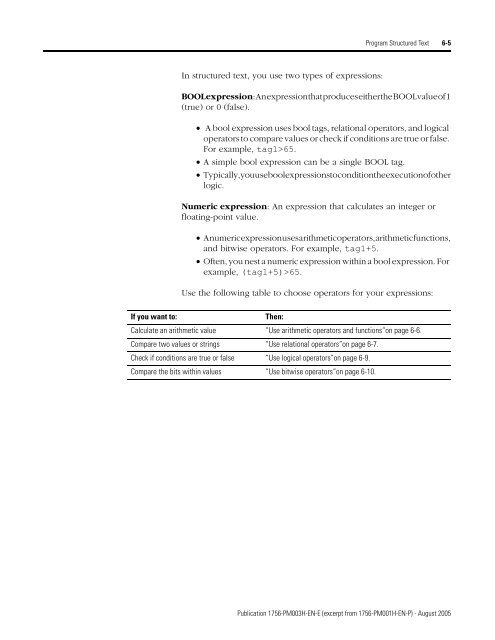1756-PM003H-EN-E, SFC and ST Programming Languages ...
1756-PM003H-EN-E, SFC and ST Programming Languages ...
1756-PM003H-EN-E, SFC and ST Programming Languages ...
You also want an ePaper? Increase the reach of your titles
YUMPU automatically turns print PDFs into web optimized ePapers that Google loves.
Program Structured Text 6-5<br />
In structured text, you use two types of expressions:<br />
BOOL expression: An expression that produces either the BOOL value of 1<br />
(true) or 0 (false).<br />
• A bool expression uses bool tags, relational operators, <strong>and</strong> logical<br />
operators to compare values or check if conditions are true or false.<br />
For example, tag1>65.<br />
• A simple bool expression can be a single BOOL tag.<br />
• Typically, you use bool expressions to condition the execution of other<br />
logic.<br />
Numeric expression: An expression that calculates an integer or<br />
floating-point value.<br />
• A numeric expression uses arithmetic operators, arithmetic functions,<br />
<strong>and</strong> bitwise operators. For example, tag1+5.<br />
• Often, you nest a numeric expression within a bool expression. For<br />
example, (tag1+5)>65.<br />
Use the following table to choose operators for your expressions:<br />
If you want to:<br />
Then:<br />
Calculate an arithmetic value “Use arithmetic operators <strong>and</strong> functions“on page 6-6.<br />
Compare two values or strings “Use relational operators“on page 6-7.<br />
Check if conditions are true or false “Use logical operators“on page 6-9.<br />
Compare the bits within values “Use bitwise operators“on page 6-10.<br />
Publication <strong>1756</strong>-<strong>PM003H</strong>-<strong>EN</strong>-E (excerpt from <strong>1756</strong>-PM001H-<strong>EN</strong>-P) - August 2005
















